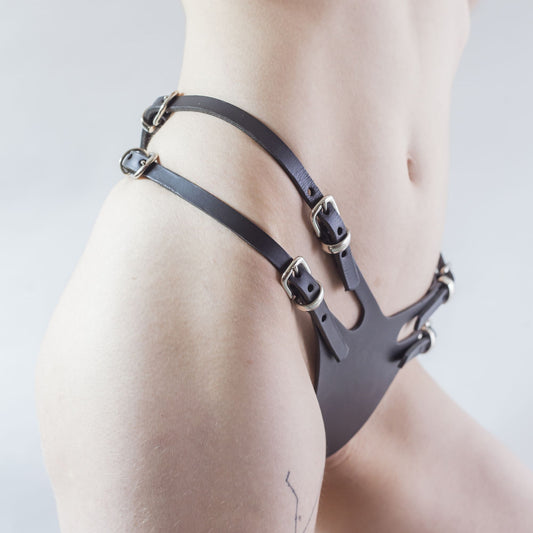Bondage is an incredibly intimate and sensual experience that can help to build trust, communication, and understanding between partners. And when it comes to bondage, nothing is quite as versatile, effective, and beautiful as the humble rope.
Whether you're a seasoned bondage enthusiast or just starting out, using ropes can add a whole new dimension to your play. From the sensations of the rope on your skin, to the control and restraint it allows, there's something truly unique about the experience of being bound. But with so many types of ropes, knots, and techniques out there, it can be difficult to know where to start.
Below we'll be exploring what you need to know about the Shibari rope, different types of ropes and what you need to consider when start using bondage ropes. So let's dive in and discover the exciting world of bondage ropes together!
The Shibari rope
Shibari rope, also known as Kinbaku rope, is a type of traditional Japanese rope bondage that involves intricate and decorative tying techniques. The art of Shibari involves using specially designed ropes made of natural fibers such as jute or hemp to bind and restrain the subject in various patterns and poses.
Shibari rope is often made from high-quality natural fibers, which allow for a comfortable and secure tie. The ropes are typically long and thin, ranging from 4-8 meters in length, and are designed to be both strong and flexible. Shibari ropes are often braided or twisted to create different textures and patterns, and can be dyed in a variety of colors to suit individual preferences.
Shibari rope tying techniques can range from simple and functional to complex and decorative, and can involve tying the subject's arms, legs, torso, and even their hair. The tying process is often viewed as a form of meditative art, requiring patience, skill, and communication between the rigger and the subject. Shibari has become a popular practice within the BDSM community, but it's important to note that it should always be performed safely, with consent, and with an understanding of the risks involved.
Different types of bondage ropes
There are several types of bondage ropes available in the market, each with different properties and characteristics. Here are some of the most common types of bondage ropes:
Cotton rope
Cotton rope is a soft and lightweight rope that is easy to handle and tie. It is a popular choice for beginners as it is affordable and readily available. However, cotton rope tends to stretch over time and may lose its shape after repeated use.
Jute rope
Jute rope is a natural fiber rope that is strong and durable. It has a rough texture, which can provide a more intense sensation during play. However, jute rope can be more difficult to handle and tie than cotton rope.
Hemp rope
Hemp rope is a natural fiber rope that is strong, durable, and has a rough texture. It is a popular choice for bondage as it can withstand the tension and weight of a person's body. However, hemp rope can be more expensive and difficult to find than other types of rope.
Nylon rope
Nylon rope is a synthetic rope that is strong, durable, and easy to handle. It is a popular choice for bondage as it is lightweight, does not stretch, and can be easily cleaned. However, nylon rope can be more expensive than other types of rope.
Silk rope
Silk rope is a soft and smooth rope that feels luxurious against the skin. It is a popular choice for bondage as it provides a sensual and erotic experience. However, silk rope is less durable than other types of rope and may not withstand the tension and weight of a person's body.
When selecting a bondage rope, it is important to consider factors such as strength, durability, texture, and ease of handling. It is also important to choose a rope that is appropriate for the level of bondage play and experience of the participants involved.
Ok, so how do I use a bondage rope?
Before using a bondage rope, it is important to have a clear understanding of basic rope safety principles, such as avoiding tying knots too tightly, having scissors or a knife nearby for quick release in case of emergency, and regularly checking the bound person's circulation and comfort level. Here are some general steps for using a bondage rope:
- Choose a rope: Select a rope that is appropriate for the type of bondage you are planning to do, and make sure it is clean and in good condition.
- Prepare the rope: Untangle the rope and cut it to the desired length. Some people prefer to wash the rope before use to remove any dirt or debris.
- Learn basic knots: Learn how to tie basic knots, such as the single column tie and the double column tie. You can find many tutorials online or in books on rope bondage.
- Begin tying: Start by tying the person's wrists or ankles, or any other body part that you wish to restrain. Take your time and communicate with your partner throughout the process to ensure their comfort and safety.
- Check for comfort and circulation: After tying each body part, check to make sure that the rope is not too tight and that the person can still move their fingers or toes. You should also regularly check for signs of discomfort or numbness.
- End the session: When you are ready to end the bondage session, remove the rope carefully, making sure not to pull it too hard or cause any discomfort to your partner. Always have a pair of scissors or a knife nearby in case of emergency.
Remember that rope bondage should be a fun and exciting activity, but it also requires a great deal of trust and communication between partners. Always prioritize safety and respect your partner's boundaries and comfort level.
Good luck with you new bondage experience!





